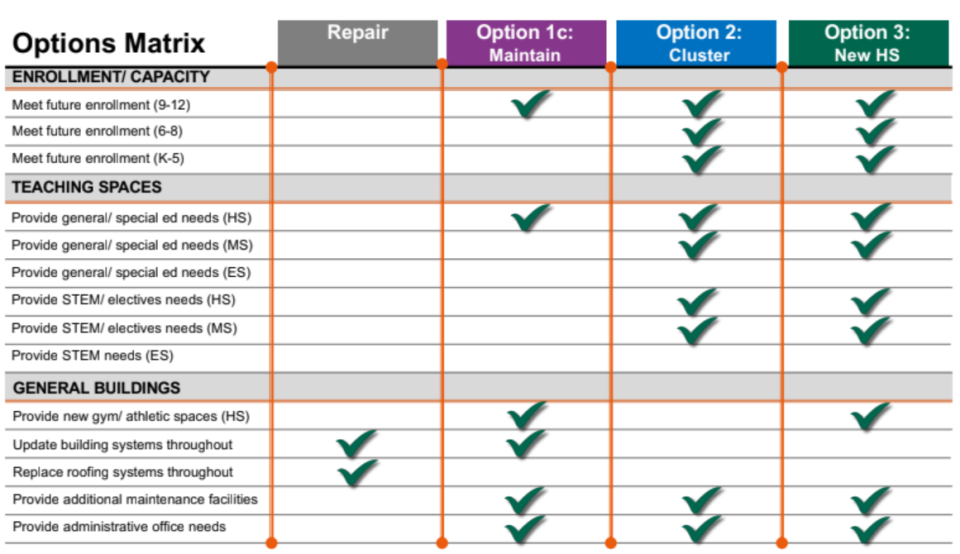Palmyra school board looks to address growth, updating buildings with feasibility study
Palmyra Area School District will hold a public forum on Nov. 14 in the auditorium of the middle school at 6 p.m. for a presentation on the district's feasibility study.
Residents will be able to comment and ask questions about the study.
Board members were given a similar presentation by the architects on Oct. 12, the slides of which can be found on the districts website at pasd.us/feasibility-study-2023.
District Supt. Bernie Kepler said that the feasibility study is looking to address the overcrowding in the district as well as the needs of the buildings themselves
According to the presentation slides, all of the district facilities, while structurally in good condition, require some kind of updating or repairs, and are in need additional space of some kind.
The average square foot per student in elementary schools is between 130-150, the district's facilities are 122-131. In the middle school, where the average is 150-170 square foot per student, the district has 130. In the high school, the district has 147 square foot per student where the average is 185-200.
"We're busting at the seams," Kepler said. "High school is the tightest, middle school followed and elementary we have some capacity availability, but not for the foreseeable future. We're aware of what growth is coming from working with our municipal officials. We know what land developers now own and know what's coming down the road for five years, 10 years."
"We're working to position the district long-term for that growth."
The presentation offered four options:
For the district to just maintain and repair its facilities, replacing the roofs in all of its schools as well as mechanical, lighting and painting in three schools, an option that would not address capacity issues in its buildings, the estimated cost would be between $62,870,000 and $72,850,000.
The first option, split into three sub options, would could cost between $97,210,000 and $161,210,000, depending on how and where they decided to allocate resources, but the option would allow the district to keep all grades in their current buildings.
Clustering grades, which would keep Lingle Avenue and Pine Street elementary schools, turn Northside into a grade 4-6 intermediate school, 7-8 grade in the middle school, provide additions and renovations to the high school, and relocate the district office would cost between $144,520,000 and $177,950,000. The Forge Road Elementary school would not be used for education and could become the district office.
The third option, building a new high school, would move 6-8 grades into the existing high school, move grades four and five into the middle school as an intermediate school and retain Lingle Avenue and Pine Street elementary schools, would cost between $156,780,000 and $179,590,000. Both the Forge Road and Northside Elementary schools would no longer be used for education.

During the Oct. 19 board of education meeting, resident Joyce Massar spoke on the feasibility study.
"Last year I came before the school board for the proposed tax increase which was at the time a number between 2.85 and 3 plus percent," Massar said. "I had heard a member of the board say 'for the average homeowner it's only going to be about $100.' When I spoke to the board I said to that member that the $100 increase was probably going to put my mother out of her house, because she cannot afford that on her limited, very limited, fixed income and I didn't have the extra to help her."
Massar explained that she had been absent from school board meetings over the last eight months because she was helping her mother move out of her house and sell it. She later explained that the person who bought her mother's house was a woman who had four children, three of them who looked to be high school age and one who looked to be elementary age.
"So instead of having one 84-year-old lady living in the house with no kids in the district, you now have four more kids to be responsible for in the district. Maybe more, because she wanted the big house for her growing family. And I am confident in saying that my mother is probably not the only one in Palmyra that this has or will happen to."
Dave Laudermilch also discussed the feasibility study, saying that he personally was not a fan of any of the options proposed in the plan, but hopes that a path forward can be found by cobbling together pieces of each of the solutions. He was particularly concerned with areas of the study that compromised building improvements for repairs to athletic fields.
Board President Joshua Jones also commented on the feasibility study immediatly after public comment, addressing some of those concerns.
"Guys, I hear everybody," Jones said. "Mr. Laudermilch, I hear you with the roofs, I hear you with this, and I, in case you missed it, I did weigh in. I'm fine with whatever decision we honestly want to go with. But make no mistake about it, we are $100 million, to either fix the buildings and do nothing for growth, nothing for better academic resources, nothing for athletics, nothing for whatever and that's your path. You will never be able to expand beyond that.
He added, "$100 million is about the cap of where we can borrow money from and every 15 to 20 years you will spend the same $100 million plus on doing that."
Daniel Larlham Jr. is a reporter for the Lebanon Daily News. Reach him at DLarlham@LDNews.com or on X @djlarlham.
This article originally appeared on Lebanon Daily News: Capacity, aging buildings top concerns in Palmyra PA school district

